Phyllis: The first real snow has fallen overnight, and the quality of light when I wake up is luminous outside the window. Solstice approaches, and we’ve turned our thoughts to books about winter and snow. So many to choose from! Here are a few.
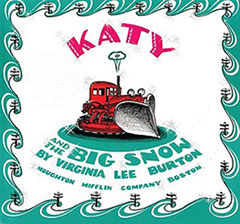 When my grown daughter saw a copy of Katy and the Big Snow by Virginia Lee Burton on my bookshelf, she cried, “Oh! Katy!” Since it was first published in 1943, this book has been beloved by children and grown-ups alike. Katy, “a beautiful red crawler tractor,” works as a bulldozer in the summer and even pulls a steamroller out of the pond when it falls in. In winter, Katy’s bulldozer is changed out for her snow plow, but she is “so big and strong” that she must stay in the garage until enough snow falls for her to plow. When the Big Snow finally does pile up with drifts up to second story windows, the other plows break down and Katy comes to the rescue. She plows out the city’s roads so the mail can get through (remember when mail was a main way to communicate?), telephones poles can be repaired, broken water mains fixed, patients can get to hospitals, fire trucks can reach fires, airplanes can land on cleared runways, and all the side streets are plowed out. “Then … and only then did Katy stop.” I’ve lived in Minnesota through enough winters to see houses on the prairie buried by snowdrifts and trick-or-treaters struggling through the three-foot deep Halloween blizzard. Thanks to Katy and her kin, we get around eventually, and thanks to Virginia Burton we can share in Katy’s triumph. And what child doesn’t love big machines?
When my grown daughter saw a copy of Katy and the Big Snow by Virginia Lee Burton on my bookshelf, she cried, “Oh! Katy!” Since it was first published in 1943, this book has been beloved by children and grown-ups alike. Katy, “a beautiful red crawler tractor,” works as a bulldozer in the summer and even pulls a steamroller out of the pond when it falls in. In winter, Katy’s bulldozer is changed out for her snow plow, but she is “so big and strong” that she must stay in the garage until enough snow falls for her to plow. When the Big Snow finally does pile up with drifts up to second story windows, the other plows break down and Katy comes to the rescue. She plows out the city’s roads so the mail can get through (remember when mail was a main way to communicate?), telephones poles can be repaired, broken water mains fixed, patients can get to hospitals, fire trucks can reach fires, airplanes can land on cleared runways, and all the side streets are plowed out. “Then … and only then did Katy stop.” I’ve lived in Minnesota through enough winters to see houses on the prairie buried by snowdrifts and trick-or-treaters struggling through the three-foot deep Halloween blizzard. Thanks to Katy and her kin, we get around eventually, and thanks to Virginia Burton we can share in Katy’s triumph. And what child doesn’t love big machines?
Jackie: Big machines are automatic attention-grabbers. And I love the certainty of this world. There are problems to be solved in this big snow and Katy can solve them. So, the mail gets through, the sick people get treated, the fire trucks put out fires. It feels safe. And that is such a good feeling for a child — and for all of us. We adults may know that things don’t always work out that neatly, but it’s nice, even for us, to visit a world where they do work out.
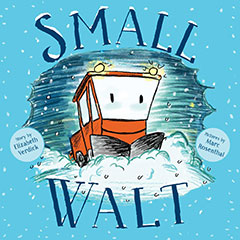 Phyllis: Small Walt by Elizabeth Verdick with pictures by Marc Rosenthal has just been published, and Katy’s descendant Walt waits, too, for a chance to plow snow. Unlike Katy who must wait for a big snow, Walt, the smallest plow in the fleet, must wait and wait for someone willing to take out “the little guy” when a snowstorm buries the streets and all the big plows and their drivers go out to clear the roads.. Enter Gus, who checks out Walt and drives him on his route. Walt chugs along, his engine thrumming his song:
Phyllis: Small Walt by Elizabeth Verdick with pictures by Marc Rosenthal has just been published, and Katy’s descendant Walt waits, too, for a chance to plow snow. Unlike Katy who must wait for a big snow, Walt, the smallest plow in the fleet, must wait and wait for someone willing to take out “the little guy” when a snowstorm buries the streets and all the big plows and their drivers go out to clear the roads.. Enter Gus, who checks out Walt and drives him on his route. Walt chugs along, his engine thrumming his song:
My name is Walt.
I plow and salt,
They say I’m small,
But I’ll show them all.
And Walt does, until they confront a high hill with drifts bigger than Walt has ever seen. Gus suggests they can let Big Buck behind them plow the hill, but Walt is determined. He “skids, slips down, down…He shudders, sputters.” When they finally make it to the top of the hill and down, dawn has arrived and they head back to the city lot where Big Buck says, “The little guy did a better job than I thought.” Replete with onomatopoetic sounds, rhythm, and syntax, this is a wonderful read-aloud. The art is reminiscent in color and line of Burton’s art, and Walt, like Katy, is a jaunty red. A great pairing of books when the snow piles high.
Jackie: This is such a satisfying story. And as you said, Phyllis, the language is wonderful. My favorite, and I may adopt it this winter, is, “Plow and salter. Never falter.” There are days when it’s good to remember not to falter, whether or not salt is in the picture.
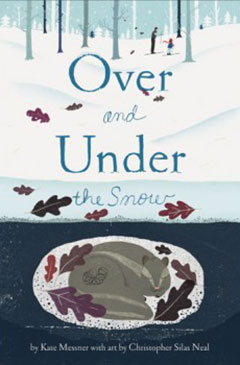 Phyllis: Over and Under the Snow by Kate Messner with art by Christopher Silas Neal chronicles a winter day skiing where a “whole secret kingdom” exists out of sight under the snow that a child and parent glide, climb, and swoosh over. Fat bullfrogs snooze, snowshoe hares watch from under snow-covered pines, squirrels, shrews, voles, chipmunks, queen bumblebees hide under the snow where deer mice “huddle up, cuddle up. And a bushy-tailed red fox leaps to catch the mouse that his sharp ears detect scritching beneath the snow. Extensive back matter offers scientific information about how the animals survive winter. Reading this book makes me want to strap on skis and go gliding through a snowy world over a secret kingdom.
Phyllis: Over and Under the Snow by Kate Messner with art by Christopher Silas Neal chronicles a winter day skiing where a “whole secret kingdom” exists out of sight under the snow that a child and parent glide, climb, and swoosh over. Fat bullfrogs snooze, snowshoe hares watch from under snow-covered pines, squirrels, shrews, voles, chipmunks, queen bumblebees hide under the snow where deer mice “huddle up, cuddle up. And a bushy-tailed red fox leaps to catch the mouse that his sharp ears detect scritching beneath the snow. Extensive back matter offers scientific information about how the animals survive winter. Reading this book makes me want to strap on skis and go gliding through a snowy world over a secret kingdom.
Jackie: I had that same thought — “where are my skis? Where is the snow?” It’s so much fun in this book to see into places we don’t usually see, the vole’s tunnel, the beavers’ den, the place in the mud where the bullfrog lives. It’s like being given a magic pill that makes us small enough to get into these places, usually locked to us. And I love the back information. The more we know the more we see when we look. And the more connection we have to what is under the snow.
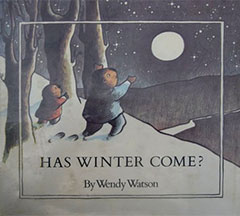 Phyllis: Another old favorite in our family is Wendy Watson’s Has Winter Come? I love Wendy Watson’s work, and this book, text and art, enchanted me when we first read it and still does.
Phyllis: Another old favorite in our family is Wendy Watson’s Has Winter Come? I love Wendy Watson’s work, and this book, text and art, enchanted me when we first read it and still does.
On the day that it started to snow,
Mother said,
“Winter is coming now.
I can smell it in the air.”
The woodchuck children sniff but can’t smell winter. As the family gathers “acorns and walnuts, hickory nuts and hazelnuts, sunflower seed and pumpkin seeds … apples and corn, and pears and parsnips” and piles up wood to keep them warm the children keep trying to smell winter. When the snow stops falling their mother gathers a star for each of them from the starry sky. As they get ready for bed the little woodchucks smell “warm beds, and pine cones burning, and apple cores sizzling on the hearth.” As their parents tuck them under warm down quilts, the children say, “We smell sleep coming, and a long night … Is this winter?”
Yes, their parents whisper. “This is winter.” The softly colored illustrations capture falling snow, the trunks and roots of the woodchucks’ woodland home, and the small luminosities of the stars that the little woodchuck clutch in their paws as they fall asleep. Who wouldn’t want such a winter nap, cozy, and well-fed, lit by starlight and watched over by loving parents?
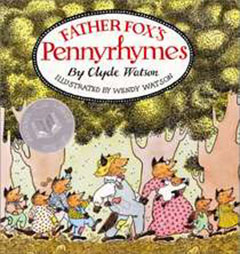 Jackie: Wendy Watson has always been one of my favorites. Her books tell a tale of family love and, like Geopolis, always present readers a wonderful world to visit. At our house we spent many contented hours enjoying the pictures and poring over the rhymes in Father Fox’s Pennyrhymes, written by Clyde Watson and illustrated by her sister, Wendy.
Jackie: Wendy Watson has always been one of my favorites. Her books tell a tale of family love and, like Geopolis, always present readers a wonderful world to visit. At our house we spent many contented hours enjoying the pictures and poring over the rhymes in Father Fox’s Pennyrhymes, written by Clyde Watson and illustrated by her sister, Wendy.
As a result of working on this column I have visited Wendy Watson’s web page and especially love her blog, with its family tales and recipes.
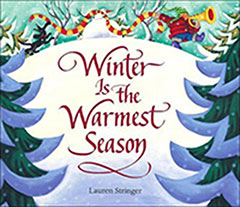 Phyllis: Lauren Stringer’s Winter is the Warmest Season offers proof in spare text and exuberant illustrations that, contrary to what we might think, winter is indeed our warmest time. Puffy jackets, hats that “grow earflaps,” hands wearing wooly sweaters, a good cup of something warm to drink, cats that curl in laps, cozy blankets and starry quilts to snuggle under, fires and candles, hot baths, and a book to read cuddled close by people who love us will all warm our hearts as the snow piles up outside.
Phyllis: Lauren Stringer’s Winter is the Warmest Season offers proof in spare text and exuberant illustrations that, contrary to what we might think, winter is indeed our warmest time. Puffy jackets, hats that “grow earflaps,” hands wearing wooly sweaters, a good cup of something warm to drink, cats that curl in laps, cozy blankets and starry quilts to snuggle under, fires and candles, hot baths, and a book to read cuddled close by people who love us will all warm our hearts as the snow piles up outside.
Jackie: This is an ode to the joys of winter. It reminds me of the appreciation we all have for hot chocolate (which of course tastes best, when one is a little chilled), fireplaces, and the sweetness of being warmed after being cold. This book begs readers to create a companion — Summer is the Coolest Season. This would be a fun classroom writing assignment.
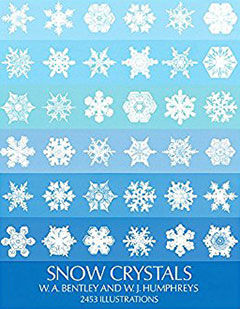 We started this column with mounds of snow that had to be cleared away for village life to continue. We looked under the snow, found winter, and found it to be warm. I’d like to add a look at individual snow crystals. Because Snowflake Bentley is on our list of additional books [Thanks Phyllis!] I want to mention that his book of snow crystal photographs is still in print—Snow Crystals—and is published by Dover Publications. Also, Voyageur, in 2006 published Kenneth Libbrecht’s A Field Guide to Snowflakes, photographs of snow crystals taken with a more modern camera than Bentley’s.
We started this column with mounds of snow that had to be cleared away for village life to continue. We looked under the snow, found winter, and found it to be warm. I’d like to add a look at individual snow crystals. Because Snowflake Bentley is on our list of additional books [Thanks Phyllis!] I want to mention that his book of snow crystal photographs is still in print—Snow Crystals—and is published by Dover Publications. Also, Voyageur, in 2006 published Kenneth Libbrecht’s A Field Guide to Snowflakes, photographs of snow crystals taken with a more modern camera than Bentley’s.
Phyllis: Whether you are tucked under a warm blanket or gliding through snowy woods over creatures tucked in beneath your feet, we wish you the warmth of loved ones, the wonder of snow crystals, a pile of books to read, and a peaceful time as the earth tilts into winter and toward the solstice light.
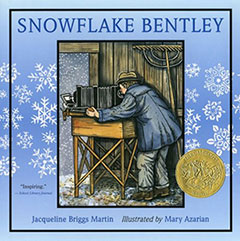 A few more of the blizzard of books about snow and winter:
A few more of the blizzard of books about snow and winter:
- Brave Irene by William Steig
- Snowflake Bentley by Jackie Briggs Martin (Jackie might not mention this book, but Phyllis will) and Mary Azarian
- Snowflakes Fall by Patricia MacLachlan and Steven Kellogg
- Snowy Day by Ezra Jack Keats
